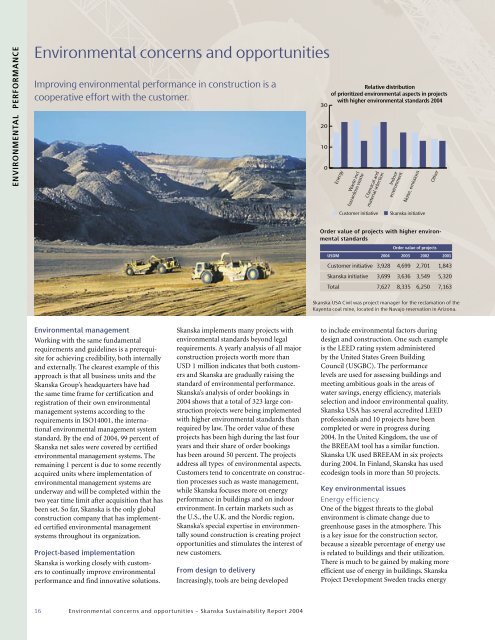SUSTAINABILITY REPORT 2004 - Skanska
SUSTAINABILITY REPORT 2004 - Skanska
SUSTAINABILITY REPORT 2004 - Skanska
Create successful ePaper yourself
Turn your PDF publications into a flip-book with our unique Google optimized e-Paper software.
ENVIRONMENTAL PERFORMANCE<br />
Environmental concerns and opportunities<br />
Improving environmental performance in construction is a<br />
cooperative effort with the customer.<br />
<br />
<br />
<br />
<br />
<br />
<br />
<br />
<br />
<br />
<br />
<br />
<br />
<br />
<br />
<br />
<br />
<br />
<br />
Order value of projects with higher environmental<br />
standards<br />
Order value of projects<br />
USDM <strong>2004</strong> 2003 2002 2001<br />
Customer initiative 3,928 4,699 2,701 1,843<br />
<strong>Skanska</strong> initiative 3,699 3,636 3,549 5,320<br />
Total 7,627 8,335 6,250 7,163<br />
<strong>Skanska</strong> USA Civil was project manager for the reclamation of the<br />
Kayenta coal mine, located in the Navajo reservation in Arizona.<br />
Environmental management<br />
Working with the same fundamental<br />
requirements and guidelines is a prerequisite<br />
for achieving credibility, both internally<br />
and externally. The clearest example of this<br />
approach is that all business units and the<br />
<strong>Skanska</strong> Group’s headquarters have had<br />
the same time frame for certification and<br />
registration of their own environmental<br />
management systems according to the<br />
requirements in ISO14001, the international<br />
environmental management system<br />
standard. By the end of <strong>2004</strong>, 99 percent of<br />
<strong>Skanska</strong> net sales were covered by certified<br />
environmental management systems. The<br />
remaining 1 percent is due to some recently<br />
acquired units where implementation of<br />
environmental management systems are<br />
underway and will be completed within the<br />
two year time limit after acquisition that has<br />
been set. So far, <strong>Skanska</strong> is the only global<br />
construction company that has implemented<br />
certified environmental management<br />
systems throughout its organization.<br />
Project-based implementation<br />
<strong>Skanska</strong> is working closely with customers<br />
to continually improve environmental<br />
performance and find innovative solutions.<br />
<strong>Skanska</strong> implements many projects with<br />
environmental standards beyond legal<br />
requirements. A yearly analysis of all major<br />
construction projects worth more than<br />
USD 1 million indicates that both customers<br />
and <strong>Skanska</strong> are gradually raising the<br />
standard of environmental performance.<br />
<strong>Skanska</strong>’s analysis of order bookings in<br />
<strong>2004</strong> shows that a total of 323 large construction<br />
projects were being implemented<br />
with higher environmental standards than<br />
required by law. The order value of these<br />
projects has been high during the last four<br />
years and their share of order bookings<br />
has been around 50 percent. The projects<br />
address all types of environmental aspects.<br />
Customers tend to concentrate on construction<br />
processes such as waste management,<br />
while <strong>Skanska</strong> focuses more on energy<br />
performance in buildings and on indoor<br />
environment. In certain markets such as<br />
the U.S., the U.K. and the Nordic region,<br />
<strong>Skanska</strong>’s special expertise in environmentally<br />
sound construction is creating project<br />
opportunities and stimulates the interest of<br />
new customers.<br />
From design to delivery<br />
Increasingly, tools are being developed<br />
to include environmental factors during<br />
design and construction. One such example<br />
is the LEED rating system administered<br />
by the United States Green Building<br />
Council (USGBC). The performance<br />
levels are used for assessing buildings and<br />
meeting ambitious goals in the areas of<br />
water savings, energy efficiency, materials<br />
selection and indoor environmental quality.<br />
<strong>Skanska</strong> USA has several accredited LEED<br />
professionals and 10 projects have been<br />
completed or were in progress during<br />
<strong>2004</strong>. In the United Kingdom, the use of<br />
the BREEAM tool has a similar function.<br />
<strong>Skanska</strong> UK used BREEAM in six projects<br />
during <strong>2004</strong>. In Finland, <strong>Skanska</strong> has used<br />
ecodesign tools in more than 50 projects.<br />
Key environmental issues<br />
Energy efficiency<br />
One of the biggest threats to the global<br />
environment is climate change due to<br />
greenhouse gases in the atmosphere. This<br />
is a key issue for the construction sector,<br />
because a sizeable percentage of energy use<br />
is related to buildings and their utilization.<br />
There is much to be gained by making more<br />
efficient use of energy in buildings. <strong>Skanska</strong><br />
Project Development Sweden tracks energy<br />
16 Environmental concerns and opportunities – <strong>Skanska</strong> Sustainability Report <strong>2004</strong>

















